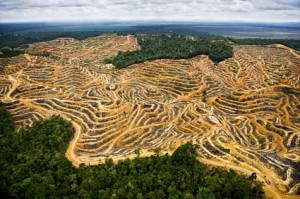By 2020, Indonesian Palm Oil Plantations Will Release More CO2 Than Canada
 Palm oil plantation expansion in Indonesia is set to release more than 558 million metric tons of carbon dioxide by 2020, according to a report published Sunday in Nature Climate Change. That’s more than Canada’s yearly CO2 emissions.
Palm oil plantation expansion in Indonesia is set to release more than 558 million metric tons of carbon dioxide by 2020, according to a report published Sunday in Nature Climate Change. That’s more than Canada’s yearly CO2 emissions.The study, conducted by researchers from Yale and Stanford, examined palm oil plantation development in the Kalimantan region of Indonesia from 1990 to 2010. Using Landsat satellite images and carbon accounting, the researchers analyzed land cover changes over the 20-year period, estimated the carbon emissions from the plantations and projected the levels of carbon emitted between 2010 and 2020 under Business as Usual and protection scenarios. Here’s what they found:
•In 1990, oil palm plantations covered 903 square kilometers of Kalimantan – by 2010 that number had grown to 31,640 km2.
•Between 2000 and 2010, forest clearing for palm plantations contributed to about 57 percent of Indonesia’s total deforestation.
•Palm growth occurs on government-awarded land leases, 79 percent of which remain undeveloped. The development of the remaining leases would convert 93,844 km2 of land to palm plantations, 90 percent of which is forested and 18 percent of which is peatland.
It’s oil palm’s method of growth that makes it such a high-emissions crop. In Indonesia and Malaysia, which grow and produce 90 percent of the world’s palm oil, rainforests are cleared and sometimes burned to make way for plantations. The emissions from this deforestation are multiplied when the clearing occurs on peatlands, which store vast quantities of carbon. The study found that, as of 2010, 13 percent of Kalimantan’s palm oil plantations were situated on peatlands.
The study comes after the EPA’s decision this January to deny palm oil’s use as a biofuel in the Renewable Fuel Standard, which mandates that 36 billion gallons of biofuels be incorporated into American transportation fuel mix by 2022. The EPA’s analysis of the use of palm oil for biodiesel found that it reduced greenhouse gas emissions by 17 percent, falling short of the 20 percent benchmark necessary for a fuel to be included in the standard.
Many scientific and environmental groups applauded the EPA’s decision but claimed the agency underestimated palm oil emissions in its analysis, arguing that the greenhouse gas emissions from palm oil’s lifecycle are actually higher than petroleum-based diesel. During an extended commenting period for the EPA analysis, the Union of Concerned Scientists released a report that attempts to correct several of the EPA’s conclusions on palm oil.
The commenting period for the analysis closed April 27, but the EPA has yet to make a final decision on palm oil’s use as a biofuel. As of May, the palm oil industry has hired lobbyist Holland & Knight to help convince the EPA of palm oil’s viability as a renewable fuel. In its analysis, the EPA estimates that 104,000 hectares, or 1,040 km2, of land in Indonesia and Malaysia would be converted to palm plantation if palm oil were accepted as a biofuel source.
But even if the EPA sticks to its original ruling, the fight against palm oil is far from over: palm oil accounts for more than 30 percent of the world’s vegetable oil production, and worldwide demand of the oil is expected to double by 2020. According to the report by the Union of Concerned Scientists, 70 percent of demand for palm oil is food related. This figure puts at least some of palm oil’s future in the hands of consumers: we can’t help make the EPA’s decision (since the commenting period is over), but we can wage a campaign against palm oil in our favorite foods and avoid products made with palm oil.
You can return to the main Market News page, or press the Back button on your browser.

